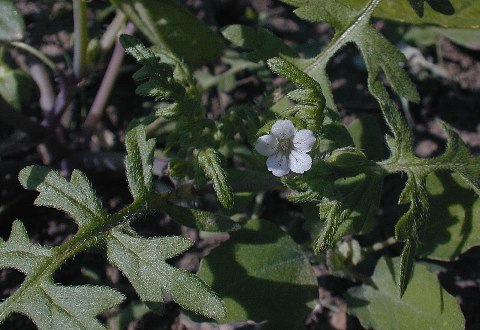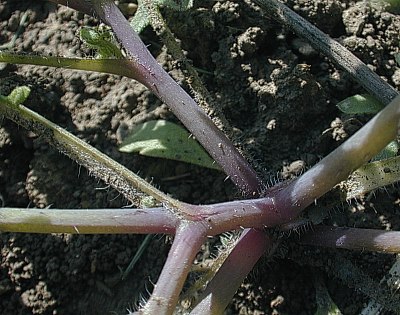Description: This wildflower is a spring annual about 4-16" tall; it branches occasionally and is more or less erect. The stems are rather thick and succulent, pale green to pale purple, and glaucous; they have widely scattered to dense tufts of long white hairs. The lower leaves are opposite, while the upper leaves are alternate; they are widely spreading. Each leaf is up to 4" long and 1" across; it is simple pinnate or pinnate-pinnatifid in structure and oblong-ovate in outline. There are 7-13 narrow leaflets (or narrow lobes) on each leaf; they can be opposite or alternate. Each leaflet has 3-5 large teeth or cleft lobes. The upper surface of each leaf is medium to dark green and hairy. At the base of each leaf, there is a stout petiole that is flattened on top and somewhat hairy.

Individual flowers
up to ¼" across are produced from the axils of the upper leaves; their
pedicels are short, slender, and hairy. Each flower has a white or pale
blue corolla with 5 petal-like lobes and a hairy green calyx with 5
large teeth. There may be fine purple lines within the interior of the
corolla and tiny specks of purple on the petal-like lobes. The blooming
period occurs from late spring to early summer and lasts about 1½
months. The flowers open up during the day; only a few flowers are in
bloom at the same time. The corollas soon fall off, while the teeth of
the calyxes become enlarged, spreading outward from their seed
capsules. Each seed capsule is globoid, slightly bifid, and hairy; it
contains 4 seeds. The seeds are brown, ovoid, and finely pitted. The
root system consists of a taproot.
Cultivation:
The preference is partial sun to light shade, moist to mesic
conditions, and a fertile loamy soil with abundant organic matter. Most
vegetative growth occurs during the spring; the foliage turns yellow
and withers away during the summer.
Range & Habitat:
The native Aunt Lucy is occasional to locally common in most areas of
Illinois,
except the SE section of the state, where it is uncommon or absent (see
Distribution
Map). Habitats include deciduous woodlands, gardens and
nurseries, partially shaded areas along buildings, and waste places.
This wildflower prefers locations where the ground vegetation is scant
as a result of overhead shade or a recent disturbance.

Faunal
Associations:
The nectar of the flowers attracts various kinds of bees, including
mason bees (Osmia spp.), little carpenter bees (Ceratina
spp.), Halictid bees, and Andrenid bees. Bee flies
(Bombyliidae) are also
attracted to the nectar of the flowers, while Syrphid flies feed mostly
on the pollen. According to Ada Georgia in A Manual
of Weeds (1913), the bruised
foliage of Aunt Lucy has a rank disagreeable odor, therefore it is
avoided by livestock and probably other mammalian herbivores.
Photographic Location:
The webmaster's wildflower garden in Urbana, Illinois, where this
wildflower developed spontaneously.
Comments:
Aunt Lucy is an oddball member of the Waterleaf family. It is not very
showy and often omitted from many wildflower guides. Aunt Lucy occurs
in two quite different habitats: deciduous woodlands and disturbed
areas where the ground is bare or lightly mulched. In the former
habitat, it is one of our native spring wildflowers, while in the
latter habitat it is a minor weed of nurseries and bare open ground in
cities. The leaves of Aunt Lucy are fairly distinctive and help to
distinguish it from many other kinds of plants. It resembles to some
extent Floerkia proserpinacoides (False Mermaid),
except the latter species has greenish flowers with only 3 petals and 3
sepals, and its leaflets (or lobes) are more narrow and smooth.